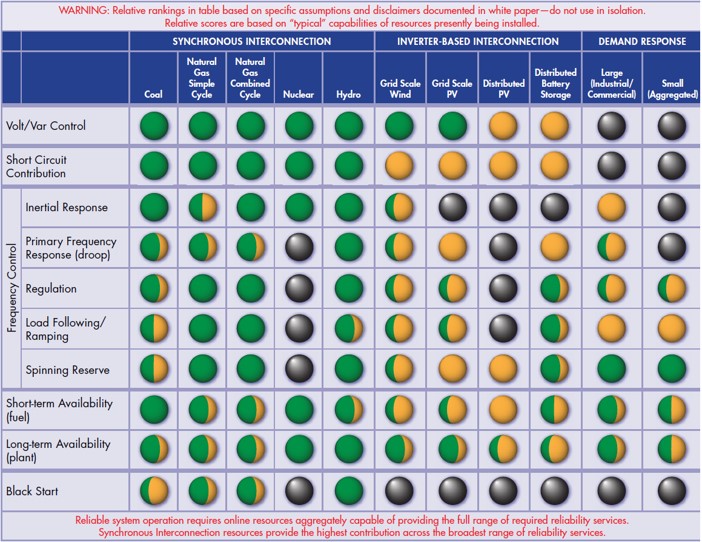
Explanation of the Benefits of a Cryogenic Energy Storage System
A power system requires several parameters for it to operate.
The figure below indicates the parameters required as well as where they can be sourced from.
Table: Relative Comparison of Reliability Contributions of Resource Groups


Reference:"Contributions of Supply and Demand Resources to Required Power System Reliability Services," Electric Power Research Institute (EPRI), Palo Alto, California, 2015.
With reference to figure above, the power system requires all parameters to be on score 5 or all green.
This is summarised below:
With reference to figure above, the power system requires all parameters to be on score 5 or all green.
This is summarised below:
1. Volt/Var control – this ensures a constant voltage for varying load cases.
2. Short circuit contribution – stable and substantial fault level is required for dip mitigation, flicker reduction and successful protection operation.
3. Frequency control – high inertia systems, spinning reserve and load following is required to ensure the frequency is maintained under fault and high load conditions.
4. Availability – ability to provide power and the above parameters irrespective of the weather or the time of day.
5. The black start refers to the ability of the synchronous generation to supply power without having to rely on a voltage reference or energy supply from an outside source.
The synchronous generation provides most of the parameters with inverter-based interconnection (IBR) providing part or nothing of the required parameters.
2. Short circuit contribution – stable and substantial fault level is required for dip mitigation, flicker reduction and successful protection operation.
3. Frequency control – high inertia systems, spinning reserve and load following is required to ensure the frequency is maintained under fault and high load conditions.
4. Availability – ability to provide power and the above parameters irrespective of the weather or the time of day.
5. The black start refers to the ability of the synchronous generation to supply power without having to rely on a voltage reference or energy supply from an outside source.
The synchronous generation provides most of the parameters with inverter-based interconnection (IBR) providing part or nothing of the required parameters.
As can be seen the distributed battery storage provides some frequency support and recently inverters can provide some voltage support. The battery storage cannot meet the full set of grid requirements. Batteries are very good for extremely short term (millisecond) response which the synchronous generators cannot really meet. Cryogenic devices, such as superconducting magnetic energy storage (SMES) devices, can operate into the microsecond range.
The Cryocopia energy storage solution with use of cryogens, such as liquid air or nitrogen driving a synchronous generator, has the benefits of a gas generator which provides most of the requirements for a robust power system including inertia. The additional benefit is that it is a renewable gas generator (if we use renewables to compress the air) unlike natural gas which is a fossil fuel.
If we then combine the generator with the cryogenic devices such as SMESs, supercapacitors and perhaps batteries, we have a device that can operate from the microsecond to the hour range. Once again using fully renewable energy.
The Cryocopia solution can be used as a support for the grid or a self-sustaining microgrid. In supporting the grid, the system can use excess heat, waste heat, to improve efficiency. This is not essential to the operation of the system, however, and can be seen as an additional benefit.
In conclusion the Cryocopia solution is a fully renewable synchronous generator with the ability to use excess heat (lower environmental effect), ability to add cryogenic devices and batteries if required and provide full grid support solutions from the microsecond to the hour range.
If we then combine the generator with the cryogenic devices such as SMESs, supercapacitors and perhaps batteries, we have a device that can operate from the microsecond to the hour range. Once again using fully renewable energy.
The Cryocopia solution can be used as a support for the grid or a self-sustaining microgrid. In supporting the grid, the system can use excess heat, waste heat, to improve efficiency. This is not essential to the operation of the system, however, and can be seen as an additional benefit.
In conclusion the Cryocopia solution is a fully renewable synchronous generator with the ability to use excess heat (lower environmental effect), ability to add cryogenic devices and batteries if required and provide full grid support solutions from the microsecond to the hour range.